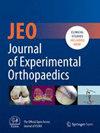The rate of smoking in patients who have suffered from ACLR graft rupture
Abstract
Purpose
The purpose of this study was to investigate the rate of smoking in patients who suffered from anterior cruciate ligament reconstruction (ACLR) graft rupture. It was hypothesised that there would be no difference in the ACLR graft rupture rates between smokers and non-smokers.
Methods
A retrospective study was conducted on patients who underwent primary ACLR using hamstring autograft at the author's institute between 2007 and 2021. Patients with unknown smoking status were excluded. All included patients received post-operative magnetic resonance imaging for assessment of graft integrity. The rate of graft rupture was reported. A case–control study was performed to determine the relationship between smoking and ACLR graft rupture by matching age, sex, chronicity of tear, diameter and type of ACLR graft, Grade 3 pivot-shift, type of ACLR and concomitant anterolateral ligament reconstruction between smokers and non-smokers.
Results
A total of 495 primary ACLRs were included. The patients were aged 27.2 ± 8.2 years. There were 397 men and 98 women, with a smoking rate of 20%. The average follow-up was 78 ± 48 months. 16.2% of smokers, compared to 10.1% of non-smokers, suffered from graft rupture. The median yearly rate of graft rupture was 2 per 100 ACLRs (interquartile range [IQR] = 2.4) for smokers, compared to 1 per 100 ACLRs (IQR = 0.6) for non-smokers. One hundred seventy-two patients were matched. Smokers were found to have a higher risk of suffering from graft rupture compared to non-smokers in the case–control matching analysis (odds ratio = 2.6, 95% confidence interval = 1.01–6.63).
Conclusion
In a cohort of 495 primary ACLRs operated using hamstring autograft with a 20% smoking rate, the rates of ACLR graft rupture and revision ACLR at a mean follow-up of 6.5 ± 4 years were 11.3% and 8.3%, respectively. Smoking was associated with an increased risk of graft rupture in a case–control matching subgroup analysis.
Level of Evidence
Level IV.


 求助内容:
求助内容: 应助结果提醒方式:
应助结果提醒方式:


